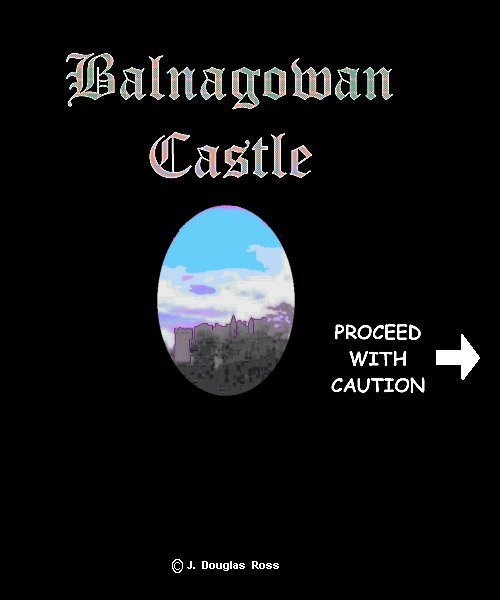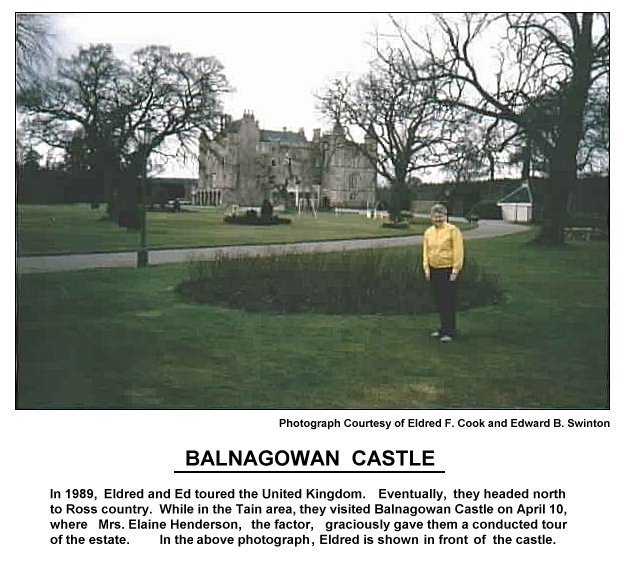|
BALNAGOWAN CASTLE
A Bit Of Haunting
Balnagowan Castle sits on a fault line, not merely a geographical one between mountains and coastal plain, but also a social one between a fiery independence and a staid community spirit. The castle reflects these tensions. The front has large windows, a welcoming porch, and battlements and turrets which are more ornamental than real although it was built as a defensive stronghold in the 14th century. After the grounds were redesigned in the mid-19th century, the raked gravel road, neat lawns and flower beds, and the lush green parkland stretched before the castle. The back is quite otherwise. Sheer walls hardly relieved by small windows stand on top of steep grassy slopes, so that the castle dominates the narrow wooded valley of the Balnagown River. The hills beyond are thickly forested and almost bare of habitation. It retains the determined defensive air that it must have had centuries years ago, when the surroundings would have been much more wild and isolated.
Traditionally, any Scottish castle worthy of the name must be hiding several skeletons behind those thick walls. In fact, the ancient Castle of Balnagowan beside the Balnagown River in the Parish of Kilmuir Easter in the County of Ross is reputed to have two ghosts, one of whom is a murdered princess whose body was sealed within the walls of the Red Corridor. The only reputable record notes that the ghost of the very gentle, friendly princess, with flowing golden hair, was seen in a grey dress walking from the dining room into the drawing room towards the Red Corridor, where it vanished.
Heavier footsteps, heard tramping along the Red Corridor, are believed to belong to Black Andrew, a 16th century laird named Andrew Monroe during his lifetime. Eventually the Chief of Clan Ross ended the evil antics of Andrew by throwing him from the top tower window of the Monument Room with a rope around his neck. Always fancying himself as a "lady's man", Black Andrew only appears when a lady visitor spends the night in the castle. [There are thirty-four bedrooms in the castle.]
A Bit Of Early History
Hugh of Rarichies took the surname of Ross, after the name of the land, in 1357. This move was made with the intent of preserving the name, when it became apparent that the Earldom of Ross was going to fall into the hands of another family, since the ancient Pictish method of succession to the title was through the female line. Upon the death of his half-brother, William, the fifth O'Beolan Earl of Ross, in 1372, Hugh Ross of Ross became the first Chief of Clan Ross and first Laird/Baron of Balnagowan in 1374. [Some historians include the five O'Beolan Earls of Ross as the earlier Chiefs of Clan Ross.]
For over 300 years, the Rosses of Balnagowan passed the title from father to son. David Ross, the twelfth Baron, incurred a heavy debt when he raised a regiment of clansmen in support of Charles II. Chief David Ross of Ross and Balnagowan was taken prisoner at the Battle of Worcester in 1651, and he died in the Tower of London. The West Tower of Balnagowan Castle was probably erected in the fifteenth century.
Above the fireplace in the Main Drawing Room of the portion built by Chief David Ross is the following carved inscription: "Soli-Deo-Gloria" (To God Above Be Glory). Another inscription, which surrounds the picture of a ministerial figure wearing a Geneva hat and gown, is "Servire-Deum-Est-Regnare" (To Serve God Is To Rule). The late Dr. John Robert Ross recalled a visit to the castle, during which a Factor (prior to the purchase by Arabs) showed him an escutcheon of three lions rampant and bearing the date 1680 carved upon the headboard of a four-post, oak bed, which carried the motto "Nobilis-Est-Ira-Leonis" (Noble Is The Wrath Of The Lion). According to the 27th Chief of Clan Ross, the latter inscription also appears upon some early Ross porcelain.
The thirteenth Chief and Laird of Balnagowan, David Ross, rebuilt the main part of the castle and added another wing during the late sixteenth century. He died childless and even further in debt than his predecessor in 1711. The estate and titles were purchased by Frances Stewart in favour of the Honourable Charles Ross, son of Lord Ross of Hawkhead (a Lowland Norman family from Renfrewshire, named de Ros, in no way related to the Rosses of Balnagowan). Upon the death of the 14th Lord Ross, Sir James Lockhart, 2nd Baronet of Carstairs, was next in line to purchase the property of Balnagowan, but the Lockhart-Rosses failed to establish a heraldic claim to the "Arms of the Rosses of Balnagowan". [In 1838, Balnagowan Castle was renovated and the Gothic East Wing was added to conform with the older sections.]
In his book, The Great Clan Ross, Dr. John Robert Ross wrote: "From the time of Malcolm Ross who became heir in 1763 to the present day, the Balnagowan Castle and estates have not been owned or controlled by the Rosses of Pitcalnie as the Chiefs of the blood of Clan Ross, even though they were the rightful heirs." If it is possible, even less consideration was given to the common clansmen and clanswomen, the exiled expatriates driven from those estates during various forms of the Highland Clearances.
In 1903, Miss Sarah Williamson Ross of Pitcalnie, a descendant of the Celtic O'Beolan Earls, was recognized by the Lord Lyon as the 27th Chief of Clan Ross. Her sister, Miss Rosa Ross, succeeded in 1957 until her death in 1968. The Chiefship and arms then transferred to the Cadet Branch of Shandwick (also descended from the Celtic Earls of Ross) ... with David Ross of Ross becoming the twenty-ninth Chief of Ross.
In a Warrant of 29th November 1999, Queen Elizabeth, Queen of Scots, through the Lord Lyon King of Arms, her "Supreme Officer of Honour on matters of heraldry and genealogy" in Scotland, agreed to grant David Ross of Ross's petition that he be recognized as David Ross of Ross and Balnagowan. This decision complemented an earlier command involving the Chief's ownership of the arms of Balnagowan.
|




